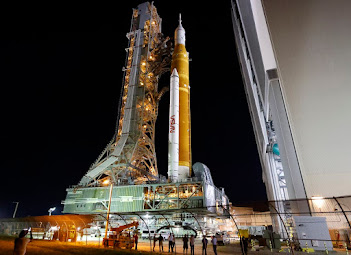For 1st test flight Nasa’s moon rocket moved to launch pad
NASA’s new moon rocket arrived at the launch pad for its first test flight last Wednesday ahead of its debut flight next week.
The 322-foot rocket emerged from its mammoth hangar late Tuesday night, drawing crowds of Kennedy Space Center workers, when NASA sent astronauts to the moon a half-century ago many of whom were not yet born. For the rocket to make the four-mile trip to the pad it took nearly 10 hours, pulling up at sunrise.
For the lunar test flight NASA is aiming for an Aug. 29 liftoff. Atop the rocket no one will be inside the crew capsule, just three mannequins swarming with sensors to measure radiation and vibration.
Before heading back for a splashdown in the Pacific, the capsule will fly around the moon in a distant orbit for a couple weeks. Further, during six weeks the entire flight should last.
Moreover, in NASA’s Artemis program the flight is the first moonshot. The main aim of the space agency is for a lunar-orbiting flight with astronauts in two years and as early as 2025 a lunar landing by a human crew.
When it established the program more than a decade ago that’s much later than NASA anticipated, as the space shuttle fleet retired. Further, billions of dollars to the cost have added to the years of delays.
NASA’s rocket program manager, John Honeycutt, said recently that “Now for the first time since 1972, we’re going to be launching a rocket that’s designed for deep space”.
For the massive five-segment boosters ground tests will provide the initial thrust and propel the rocket out of Earth’s orbit, which have been conducted at Northrop Grumman’s facilities in Promontory, Box Elder County. The Promontory site has also conducted tests for the launch abort motor that will separate the crew capsule from the rest of the rocket during launch in case of emergency.
During Apollo a half-century ago, NASA’s new SLS moon rocket, short for Space Launch System, is 41 feet (12 meters) shorter than the Saturn V rockets used. But, using a core stage and twin strap-on boosters it is more powerful, similar to the ones used for the space shuttles.
NASA Administrator Bill Nelson told reporters earlier this month that “It almost looks retro, when you look at the rocket. Toward the Saturn V it looks like we are looking back,”. “But in fact, with more sophisticated rockets and spacecraft, it’s totally new, different, and highly sophisticated.”
During Apollo twenty-four astronauts flew to the moon, with 12 of them landing on it from 1969 through 1972. Under Artemis, named after Apollo’s mythological twin sister the space agency wants a more diverse team and more sustained effort.
“I want to underscore that this is a test flight”, “It’s just the beginning”, said Nelson. The rocket’s was the third trip to the pad.
By fuel leaks and other equipment trouble a countdown test was marred in April by forcing NASA to return the rocket to the hangar for repairs. At the pad in June the dress rehearsal was repeated, with improved results.
The Howard Hughes Medical Institute’s Department of Science Education receives support from the Associated Press Health and Science Department. For all content the AP is solely responsible.
Source:- https://blogspacecap.com/for-1st-test-flight-nasas-moon-rocket-moved-to-launch-pad/




Comments
Post a Comment